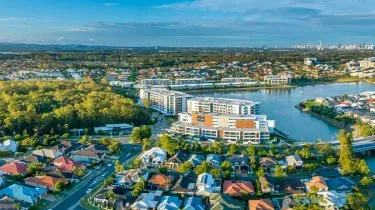Invest
ANZ expects income growth to ‘cushion’ interest rate hikes
Increased household incomes will partly offset the impacts of rising interest rates, the bank has predicted.
ANZ expects income growth to ‘cushion’ interest rate hikes
Increased household incomes will partly offset the impacts of rising interest rates, the bank has predicted.

The strong outlook for employment and wage growth moving forward will cushion the anticipated lift in rates, new analysis from ANZ has predicted.
“We expect wages to continue to accelerate through the impending cash rate hiking cycle, as they did during the 2002–08 cycle,” said ANZ senior economist Adelaide Timbrell.
“Moreover, we expect that unemployment will continue to fall, reaching a five-decade low of 3.3 per cent later this year.
“This means that some of the impact of higher interest payments and reduced borrowing capacity will be offset by higher household incomes as interest rates rise.”

Ms Timbrell explained that while higher interest rates have a negative impact on house prices, rate hikes do not always lower prices.
For example, house prices rose by more than 50 per cent during the tightening cycle of 2002-08 or an average of 8 per cent year-on-year.
“While we don’t expect to see such a strong run of housing prices through the impending tightening cycle, we do expect the correction in housing prices to be a moderate one, especially when compared with the rapid housing price growth over the last two years,” she said.
High levels of household savings are also expected to lower the risk of forced selling as interest payments rise.
ANZ has predicted that the average share of household income that services interest will remain below the long-term average even as the cash rate hits 2 per cent, which the bank expects will take place by the end of next year.
Another key distinguishing factor of the impending tightening cycle identified by ANZ is the introduction of stronger regulation that reduces financial stability risk.
“The current mortgage serviceability buffer requires prospective borrowers to prove that they can afford a mortgage at 3 ppt higher than the advertised rate,” explained Ms Timbrell.
“This equates to twelve 25bp cash rate hikes and should reduce the risk of forced selling or financial instability as the cash rate rises.”
Notably, Ms Timbrell said that a small percentage point increase would have a greater impact on interest payments than seen previously, with owner occupier variable mortgage rates poised to rise by 75 per cent as the cash rate hits 2 per cent.
“This may lead to a payment shock across some households. Though for most households, strong savings and wage growth should offset this for the most part,” she said.

Property
New investment platform Arkus allows Australians to invest in property for just $1
In a groundbreaking move to democratise investment in property-backed mortgage funds, GPS Investment Fund Limited has launched Arkus™, a retail investment platform designed to make investing ...Read more

Property
Help to Buy goes live: What 40,000 new buyers mean for banks, builders and the bottom line
Australia’s Help to Buy has opened, lowering the deposit hurdle to 2 per cent and aiming to support up to 40,000 households over four years. That single policy lever will reverberate through mortgage ...Read more

Property
Australia’s mortgage knife‑fight: investors, first‑home buyers and the new rules of lender competition
The mortgage market is staying hot even as rate relief remains elusive, with investors and first‑home buyers chasing scarce stock and lenders fighting for share on price, speed and digital experienceRead more

Property
Breaking Australia’s three‑property ceiling: the finance‑first playbook for scalable portfolios
Most Australian investors don’t stall at three properties because they run out of ambition — they run out of borrowing capacity. The ceiling is a finance constraint disguised as an asset problem. The ...Read more

Property
Gen Z's secret weapon: Why their homebuying spree could flip Australia's housing market
A surprising share of younger Australians are preparing to buy despite affordability headwinds. One in three Gen Z Australians intend to purchase within a few years and 32 per cent say escaping rent ...Read more

Property
Tasmania’s pet-positive pivot: What landlords, BTR operators and insurers need to do now
Tasmania will soon require landlords to allow pets unless they can prove a valid reason to refuse. This is more than a tenancy tweak; it is a structural signal that the balance of power in rental ...Read more

Property
NSW underquoting crackdown: the compliance reset creating both cost and competitive edge
NSW is moving to sharply increase penalties for misleading price guides, including fines linked to agent commissions and maximum penalties up to $110,000. Behind the headlines sits a more ...Read more

Property
ANZ’s mortgage growth, profit slump: why volume without margin won’t pay the dividends
ANZ lifted home-lending volumes, yet profits fell under the weight of regulatory and restructuring costs—an object lesson in the futility of growth that doesn’t convert to margin and productivityRead more

Property
New investment platform Arkus allows Australians to invest in property for just $1
In a groundbreaking move to democratise investment in property-backed mortgage funds, GPS Investment Fund Limited has launched Arkus™, a retail investment platform designed to make investing ...Read more

Property
Help to Buy goes live: What 40,000 new buyers mean for banks, builders and the bottom line
Australia’s Help to Buy has opened, lowering the deposit hurdle to 2 per cent and aiming to support up to 40,000 households over four years. That single policy lever will reverberate through mortgage ...Read more

Property
Australia’s mortgage knife‑fight: investors, first‑home buyers and the new rules of lender competition
The mortgage market is staying hot even as rate relief remains elusive, with investors and first‑home buyers chasing scarce stock and lenders fighting for share on price, speed and digital experienceRead more

Property
Breaking Australia’s three‑property ceiling: the finance‑first playbook for scalable portfolios
Most Australian investors don’t stall at three properties because they run out of ambition — they run out of borrowing capacity. The ceiling is a finance constraint disguised as an asset problem. The ...Read more

Property
Gen Z's secret weapon: Why their homebuying spree could flip Australia's housing market
A surprising share of younger Australians are preparing to buy despite affordability headwinds. One in three Gen Z Australians intend to purchase within a few years and 32 per cent say escaping rent ...Read more

Property
Tasmania’s pet-positive pivot: What landlords, BTR operators and insurers need to do now
Tasmania will soon require landlords to allow pets unless they can prove a valid reason to refuse. This is more than a tenancy tweak; it is a structural signal that the balance of power in rental ...Read more

Property
NSW underquoting crackdown: the compliance reset creating both cost and competitive edge
NSW is moving to sharply increase penalties for misleading price guides, including fines linked to agent commissions and maximum penalties up to $110,000. Behind the headlines sits a more ...Read more

Property
ANZ’s mortgage growth, profit slump: why volume without margin won’t pay the dividends
ANZ lifted home-lending volumes, yet profits fell under the weight of regulatory and restructuring costs—an object lesson in the futility of growth that doesn’t convert to margin and productivityRead more








